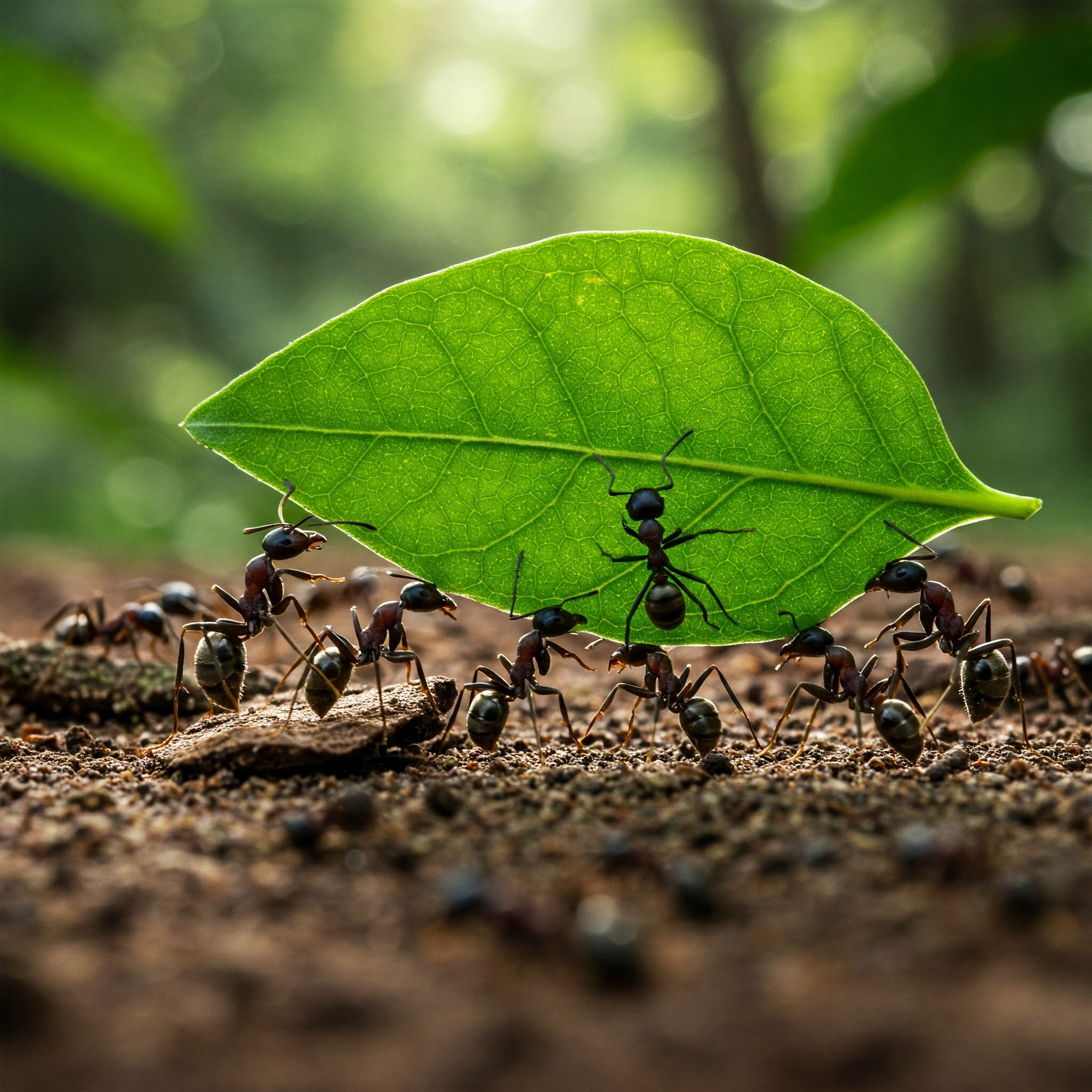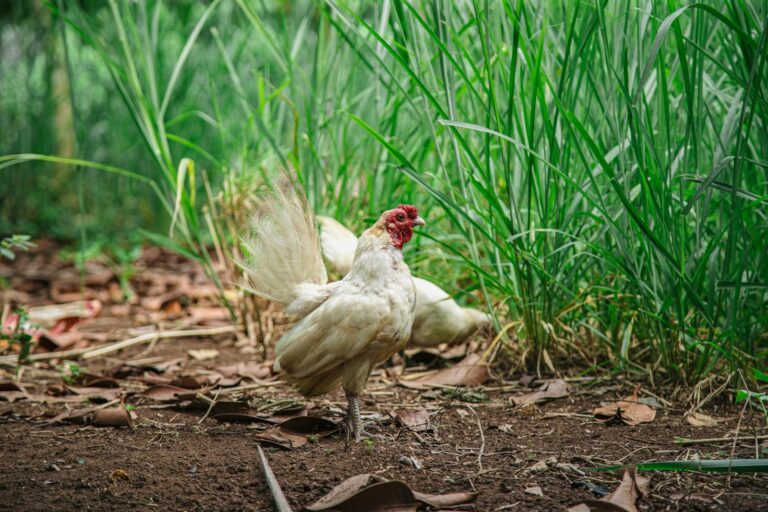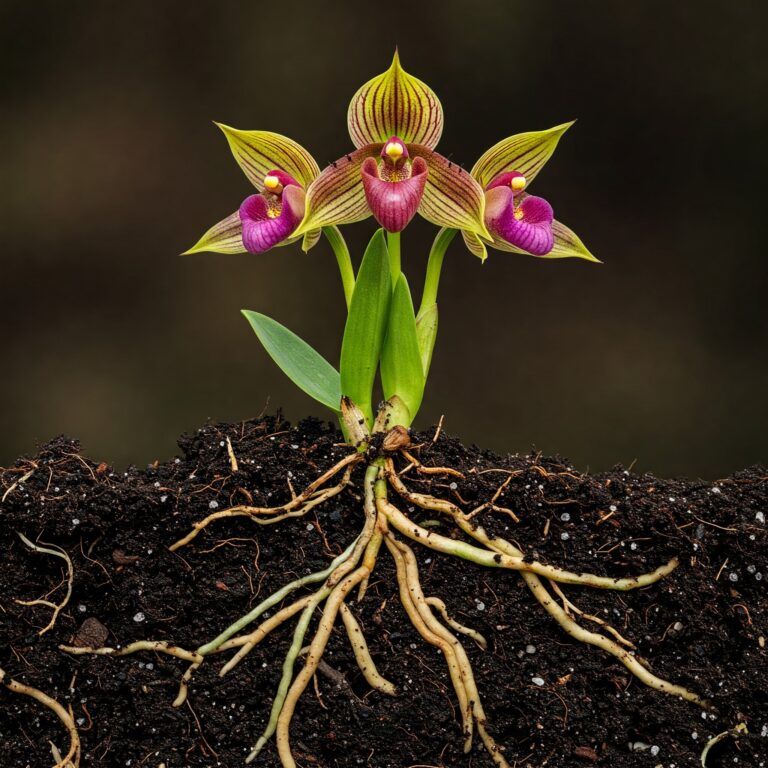The Unseen Helpers: Ants, Worms, and Other Garden Allies You Never Noticed
The other day, I was pulling weeds in my vegetable garden when I noticed something fascinating. As I disturbed the soil around a tomato plant, dozens of tiny creatures scurried, wriggled, and burrowed away from the sudden exposure to light. There were ants marching in orderly lines, earthworms quickly retreating into deeper soil, and various insects I couldn’t even name. My first instinct—like many gardeners—was concern. Are these creatures harming my precious tomatoes?
What I’ve come to realize after years of gardening and research is that most of these tiny creatures aren’t enemies but allies—the unsung heroes of our gardens. While we’re busy focusing on plant varieties, watering schedules, and fertilizer applications, an entire underground ecosystem is working tirelessly to maintain soil health, control pests, and support plant growth. These “unseen helpers” form the foundation of garden health, yet they rarely get the credit they deserve.
Think of your garden as a bustling city beneath your feet. The earthworms are like civil engineers, creating tunnels and processing organic matter. Ants serve as waste management experts, breaking down debris and controlling certain pest populations. Beneficial nematodes act as the neighborhood watch, keeping harmful organisms in check. Together, these creatures—along with billions of microscopic fungi and bacteria—create a living network that supports everything growing above ground.
In this article, we’ll explore the fascinating world of these garden allies, understand how they benefit our plants, and learn how to create environments where they can thrive. By appreciating these unseen helpers, you’ll gain a new perspective on your garden ecosystem and perhaps think twice before reaching for chemical solutions that might harm these valuable partners in gardening success.
The Soil Food Web: Understanding Your Garden’s Ecosystem

Before diving into specific creatures, it’s important to understand the concept of the soil food web—the complex community of organisms that live in the soil. This interconnected network includes everything from microscopic bacteria to visible insects, each playing a unique role in soil health.
Dr. Elaine Ingham, a leading soil microbiologist, describes the soil food web as “nature’s recycling system,” where organisms break down organic matter, make nutrients available to plants, and create soil structure. According to Ingham’s research at the Soil Foodweb Inc., a single teaspoon of healthy soil can contain up to 1 billion bacteria, several yards of fungal hyphae, thousands of protozoa, and dozens of nematodes—all invisible to the naked eye (Soil Foodweb Inc., 2020).
These organisms interact in complex food chains. For example:
- Bacteria and fungi decompose organic matter
- Protozoa and nematodes eat bacteria and fungi
- Arthropods (like insects) consume fungi and other small organisms
- Earthworms eat almost everything, including bacteria, fungi, and plant residue
Each time one organism consumes another, nutrients are released in forms that plants can use. This natural cycling process eliminates the need for chemical fertilizers in healthy soil systems.
The health of this underground ecosystem directly impacts plant health. Research from Washington State University’s Department of Crop and Soil Sciences (2022) found that vegetable gardens with diverse soil biology showed 23% higher yields and significantly better disease resistance compared to similar gardens with depleted soil life.
I experienced this firsthand in my own garden. For years, I struggled with poor tomato harvests despite following all the “right” fertilizing procedures. When I shifted my focus to building soil health through compost and minimizing soil disturbance, my garden’s productivity skyrocketed. The difference wasn’t in what I was doing for the plants, but what I was doing for the creatures supporting the plants.
Earthworms: Nature’s Soil Engineers
If garden helpers had a hall of fame, earthworms would certainly be among the first inductees. These humble creatures are perhaps the most visible of our soil allies, and their contributions to garden health are remarkable.
Charles Darwin was so fascinated by earthworms that he spent 39 years studying them, culminating in his final book, “The Formation of Vegetable Mould through the Action of Worms” (1881). Darwin concluded that “it may be doubted whether there are many other animals which have played so important a part in the history of the world, as have these lowly organized creatures.”
Modern science has confirmed Darwin’s assessment. Earthworms transform your garden in several crucial ways:
Soil Aeration and Water Infiltration
As earthworms tunnel through soil, they create channels that allow air, water, and roots to penetrate more easily. A study by the University of Minnesota Extension (2019) found that soil with abundant earthworm activity can absorb water up to 4-10 times faster than soil without worms. This improved infiltration reduces runoff and erosion while helping plants access water more efficiently.
In clay-heavy gardens particularly, earthworm tunnels can make the difference between plants thriving or struggling. The tunnels act like a natural drainage system, preventing water from pooling around roots and causing rot.
Nutrient Cycling and Soil Enrichment
The earthworm’s digestive system is a remarkable natural fertilizer factory. As worms consume organic matter, they break it down and enrich it with beneficial microbes. The result—worm castings (their waste)—contains nutrients in forms readily available to plants.
According to research from Cornell University’s Department of Soil Ecology (2021), earthworm castings contain:
- 5 times more nitrogen
- 7 times more phosphorus
- 11 times more potassium
- 2 times more calcium
- 3 times more magnesium
than the surrounding soil. These castings also contain beneficial enzymes and growth regulators that can help suppress diseases and enhance plant growth.
Soil Structure Improvement
Perhaps the most significant contribution of earthworms is how they improve overall soil structure. Their movement physically mixes soil layers, bringing deeper minerals to the surface and incorporating organic matter deeper into the profile. The sticky substances in their castings help bind soil particles together into aggregates—crumbly structures that hold both water and air, creating ideal growing conditions for plant roots.
A long-term study by the Rodale Institute (2018) found that organic plots with high earthworm populations had up to 40% more topsoil after 30 years compared to conventionally managed plots where earthworm numbers were lower.
Supporting Earthworm Populations
To encourage earthworms in your garden:
- Minimize soil disturbance (tilling damages worm tunnels and can directly harm worms)
- Maintain organic matter through mulch and compost additions
- Keep soil consistently moist but not waterlogged
- Avoid chemical pesticides and synthetic fertilizers that can harm worm populations
My neighbor Sarah transformed her compacted, clay-heavy lawn into a thriving garden primarily by focusing on earthworm support. She laid cardboard topped with compost and mulch over her lawn and left it for a season. When she peeled back this layer the following spring, the soil beneath was crumbly, dark, and teeming with earthworms that had been attracted to the decomposing cardboard and had thoroughly worked the soil below. Her “no-dig” approach had harnessed the power of earthworms to do the tilling for her.
Ants: Misunderstood Garden Allies

Unlike earthworms, which almost everyone recognizes as beneficial, ants often get a bad rap in the garden. We see them crawling on our plants or building mounds in inconvenient places and immediately reach for control methods. However, most ant species are actually providing valuable services to your garden ecosystem.
Soil Improvement and Aeration
Like tiny excavators, ants move tremendous amounts of soil as they build their nests. A study published in the Journal of Applied Ecology (2020) found that ants can move up to 13 tons of soil per acre per year in some ecosystems. This activity creates soil channels similar to those made by earthworms, improving aeration and water infiltration.
Ant tunnels are especially beneficial in compacted soils. Their movement brings deeper soil to the surface, incorporating organic matter and improving soil structure. The Xerces Society for Invertebrate Conservation notes that some ant species can tunnel more than 15 feet deep, bringing up minerals from subsoil that would otherwise be inaccessible to plants.
Seed Dispersal
Many ant species collect and store seeds, making them important plant propagators. This behavior, called myrmecochory, helps disperse the seeds of many native plants. The ants are attracted to a fatty attachment on the seeds called an elaiosome, which they feed to their larvae. After removing this nutritious part, they often discard the viable seed in their underground “trash chambers”—essentially planting it in nutrient-rich conditions ideal for germination.
At Michigan State University, researchers found that as many as 44% of spring-flowering herbaceous plants in North American forests rely on ants for seed dispersal (Michigan State University Department of Entomology, 2019). Many beloved woodland plants including trilliums, bleeding hearts, and violets depend on ants to spread their seeds.
Pest Control
Many ant species are predatory, hunting garden pests like caterpillars, fly larvae, and even termites. A colony of common garden ants can collect thousands of insects daily. Research from the University of California Integrated Pest Management Program (2022) indicates that garden plots with moderate ant populations experienced 52% fewer aphid outbreaks than plots where ants were excluded.
Even the ant-aphid relationship, often cited as proof that ants harm gardens by “farming” aphids, is more complex than it appears. While ants do protect aphids to harvest their honeydew secretions, they also prevent aphid populations from growing too large. Studies show that ants remove diseased aphids and prevent overcrowding, essentially managing the aphid population at sustainable levels.
Living with Ants
Rather than attempting to eliminate ants from your garden, consider these approaches:
- Direct them away from sensitive areas rather than killing them
- Use physical barriers like diatomaceous earth around specific plants if needed
- Recognize that occasional ant presence on plants often indicates another issue (like aphids) that needs addressing
- Learn to distinguish between helpful garden ants and problematic species like fire ants or carpenter ants
In my garden, I noticed ants frequenting my peony buds each spring. My first instinct was to remove them until I learned they were actually helping the flowers by removing the sticky coating on the buds, allowing them to open more easily. The ants got nectar, and I got beautiful blooms—a perfect example of how understanding these relationships can change our gardening practices.
Beneficial Nematodes: Microscopic Guardians
Among the smallest yet most effective garden allies are beneficial nematodes—microscopic, unsegmented worms that hunt and kill many common garden pests. These tiny creatures (most less than 1 mm long) are gardening superheroes, targeting damaging insects while leaving plants and beneficial insects unharmed.
Natural Pest Control
Beneficial nematodes seek out and infect more than 200 species of garden pests, including:
- Grubs and beetle larvae
- Fungus gnats
- Flea larvae
- Root weevils
- Cutworms and armyworms
- Many species of fly larvae
Once a nematode locates a suitable host, it enters through natural body openings and releases bacteria that quickly kill the pest. The nematodes then reproduce inside the dead pest, and new generations emerge to hunt for more hosts. This process typically happens within 24-48 hours.
Dr. Patricia Stock at the University of Arizona Department of Entomology has researched nematode effectiveness extensively. Her team’s findings suggest that properly applied beneficial nematodes can reduce target pest populations by 85-95% within days of application (University of Arizona, 2021).
Types of Beneficial Nematodes
There are many species of beneficial nematodes, but three are commonly used in home gardens:
- Steinernema feltiae: Effective against fungus gnats, thrips, and immature fleas
- Steinernema carpocapsae: Targets caterpillars, cutworms, and insects that live on soil surfaces
- Heterorhabditis bacteriophora: Seeks out deeper-dwelling pests like grubs and root weevils
These nematodes have different hunting strategies—some wait for prey to pass by, while others actively search through the soil—making a mixed-species application effective against a wider range of pests.
Supporting Nematode Populations
Unlike many commercially available beneficial insects, nematodes are likely already present in your soil at low levels. To encourage natural populations and support introduced nematodes:
- Maintain soil moisture (nematodes require a film of water to move)
- Add organic matter, which provides habitat for nematodes
- Minimize soil disturbance and avoid chemical pesticides
- Apply purchased nematodes in evening hours when UV radiation is low
A community garden in Portland, Oregon documented their experience with beneficial nematodes to control a persistent root weevil problem destroying their berry patches. After two applications of H. bacteriophora nematodes, damage decreased by approximately 80%, and the weevil population remained low for two growing seasons without additional applications. Their success inspired nearby gardeners to adopt similar biological control methods.
Pollinators Beyond Bees: The Overlooked Allies
When discussing garden pollinators, honeybees typically take center stage. However, numerous other creatures contribute significantly to pollination—many of which go unnoticed in our gardens.
Native Bees: The Pollination Powerhouses
While honeybees get most of the credit, North America’s 4,000+ species of native bees often do the heavy lifting in gardens. According to research from the University of California Berkeley’s Urban Bee Lab (2023), native bees can be up to three times more effective pollinators than honeybees for many crops.
Native bees include:
- Mason bees, which emerge early in spring to pollinate fruit trees
- Leafcutter bees, efficient pollinators of summer vegetables
- Squash bees, which specialize in cucurbit pollination
- Bumblebees, which use “buzz pollination” effective for tomatoes and peppers
Unlike honeybees, most native bees are solitary, nesting in small holes in wood, hollow plant stems, or underground tunnels. They rarely sting and don’t produce honey, but their pollination services are estimated to contribute $3 billion annually to U.S. agriculture (Xerces Society, 2022).
Flies: Unsung Pollination Heroes
Surprising to many gardeners, flies are significant pollinators for many plants. Hover flies (also called syrphid flies) are particularly valuable, as they not only pollinate flowers but their larvae voraciously consume aphids. Research from Washington State University (2021) found that a single hover fly larva can consume up to 50 aphids per day.
Other pollinating flies include bee flies, tachinid flies, and even mosquitoes. Many early-blooming plants and those with strong odors (like pawpaw trees) rely primarily on fly pollination rather than bees.
Beetles, Wasps, and Moths
The list of garden pollinators extends far beyond bees and flies:
- Beetles were among Earth’s first pollinators, evolving their relationship with plants millions of years before bees appeared
- Wasps, particularly small, non-aggressive species, visit flowers for nectar and transfer pollen
- Moths, especially at dusk and night, pollinate evening-blooming plants like evening primrose and night-blooming jasmine
Dr. Rachel Mallinger at the University of Florida’s Entomology Department notes that diverse pollinator communities lead to more complete pollination and higher yields in many crops. Her research demonstrates that gardens supporting multiple pollinator types show 35% better fruit set in tomatoes, squash, and berries compared to gardens with less pollinator diversity (University of Florida, 2020).
Creating a Pollinator-Friendly Garden
To support these diverse pollinators:
- Plant flowering species with different bloom times, shapes, and colors
- Include native plants, which have co-evolved with local pollinators
- Provide habitat like bare soil patches (for ground-nesting bees), hollow stems, and wood with beetle holes
- Minimize pesticide use, particularly broad-spectrum insecticides
- Include water sources with landing spots (like stones in a shallow dish)
A remarkable case study comes from the Lurie Garden in Chicago, where landscape designers created a 2.5-acre pollinator haven within the urban downtown. Since its establishment, researchers have documented over 300 species of pollinators in this space, demonstrating how even small, intentional gardens can support remarkable biodiversity.
Mycorrhizal Fungi: The Underground Network

Perhaps the most fascinating and least understood of our garden allies are mycorrhizal fungi—microscopic organisms that form symbiotic relationships with plant roots. These fungi essentially extend a plant’s root system, creating an underground network that connects plants and dramatically improves their nutrient uptake abilities.
The Plant-Fungi Partnership
Mycorrhizal fungi form three main relationship types with plants:
- Endomycorrhizae (arbuscular mycorrhizae): These fungi penetrate root cell walls and exchange nutrients directly with the plant. They associate with about 85% of plant species, including most garden vegetables, flowers, grasses, and shrubs.
- Ectomycorrhizae: These fungi surround root cells without penetrating them, forming a protective sheath. They typically associate with trees, especially conifers, oaks, and beeches.
- Ericoid mycorrhizae: These specialized fungi associate with plants in the heath family, like blueberries and rhododendrons.
In exchange for sugars produced by the plant through photosynthesis, these fungi provide plants with:
- Increased water absorption (expanding the root’s reach up to 700%)
- Enhanced nutrient access, particularly phosphorus and trace minerals
- Improved drought resistance
- Protection against certain soil-borne pathogens
Research from the University of British Columbia (2023) has revealed that mycorrhizal networks also facilitate communication between plants, allowing them to share resources and even warning signals about pest attacks. This “wood wide web,” as some researchers call it, means your garden plants aren’t isolated individuals but connected community members.
Benefits for Garden Plants
The advantages of robust mycorrhizal relationships are substantial. A meta-analysis published in the Journal of Applied Ecology (2022) examining 446 studies found that plants with strong mycorrhizal associations showed:
- 23% greater growth rates
- 54% better nutrient uptake
- 31% higher survival during drought
- 42% reduced susceptibility to root diseases
These benefits are particularly pronounced in challenging soil conditions or during environmental stress, essentially providing plants with a buffer against difficult growing conditions.
Supporting Mycorrhizal Networks
To encourage healthy mycorrhizal fungi in your garden:
- Minimize soil disturbance, as tilling disrupts fungal networks
- Avoid high-phosphorus fertilizers, which reduce plants’ need to form fungal partnerships
- Add organic matter through compost and mulch, which supports fungal growth
- Consider mycorrhizal inoculants when planting in severely disturbed soils
The transformation of degraded mining land in West Virginia provides a compelling example of mycorrhizal impact. Researchers found that introducing appropriate mycorrhizal fungi along with native plants accelerated ecosystem recovery by up to 15 years compared to untreated control plots. The fungi helped plants establish in the poor soil conditions and gradually rebuilt the soil ecosystem.
Working With Nature: Practical Steps for Gardeners
Understanding these unseen helpers is one thing; actively partnering with them is another. Here are practical approaches to gardening that support and enhance the work of your soil allies:
1. Adopt No-Till or Low-Till Methods
Each time soil is tilled or deeply turned, the habitat of beneficial organisms is disrupted. Earthworm tunnels are destroyed, fungal networks are broken, and many soil insects and arthropods are harmed. Research from the Rodale Institute’s 40-year farming systems trial shows that no-till organic systems:
- Support 3-5 times more earthworms
- Maintain significantly higher beneficial fungi populations
- Show better water retention and less erosion
- Eventually produce yields equal to or greater than tilled systems
For home gardeners, consider approaches like:
- Sheet mulching (layering cardboard, compost, and mulch over existing areas)
- Creating raised beds that won’t require foot traffic on growing areas
- Using broadforks to loosen soil without turning it
- Limiting soil disturbance to the specific planting area rather than the entire bed
2. Feed the Soil, Not Just the Plants
Rather than focusing exclusively on feeding plants directly with fertilizers, shift your thinking toward nourishing the soil ecosystem:
- Add organic matter regularly through compost, leaf mulch, or cover crops
- Use compost tea or extracts to introduce beneficial microorganisms
- Incorporate diverse organic materials rather than a single amendment
- Allow some plant debris to remain and decompose naturally
A study by Texas A&M University’s Department of Horticultural Sciences (2020) found that garden plots managed with a soil ecosystem approach required 62% less irrigation water and 84% less fertilizer while producing comparable yields to conventionally managed plots after a three-year transition period.
3. Create Habitat Diversity
Different beneficial organisms thrive in different microhabitats. Creating diversity in your garden supports a wider range of helpers:
- Leave some areas unmulched (for ground-nesting bees)
- Include rocks, logs, or brush piles (habitat for beetles, spiders, and other predators)
- Maintain areas with different moisture levels
- Include plants with varied growth habits and root structures
The Chicago Botanic Garden’s research on urban biodiversity (2022) demonstrated that small home gardens with intentional habitat diversity supported up to 3 times more beneficial insect species than similar-sized conventional gardens with less structural diversity.
4. Practice Thoughtful Pest Management
When pest problems arise, consider approaches that preserve beneficial organisms:
- Identify specific pests before treating
- Use targeted interventions rather than broad-spectrum pesticides
- Tolerate some level of pest activity, which supports predator populations
- Time interventions to minimize impact on beneficials
I learned this lesson in my own garden with an aphid outbreak on my kale. Rather than spraying immediately, I waited and observed. Within a week, hover flies and ladybugs had discovered the aphid buffet and quickly brought the population under control—a natural solution that required only patience.
Conclusion: Partnering with the Unseen
As we’ve explored the fascinating world of garden allies—from earthworms and ants to beneficial nematodes, diverse pollinators, and mycorrhizal fungi—a common theme emerges: our gardens are complex ecosystems rather than simple collections of plants. The health and productivity of our garden plants depend on the invisible work happening beneath the soil surface and among the stems and leaves.
By shifting our gardening approach from controlling nature to cooperating with it, we can create more resilient, productive, and sustainable gardens. This doesn’t mean abandoning all intervention, but rather intervening with greater awareness of how our actions affect the entire garden ecosystem.
Start small—perhaps by reducing tilling in one bed, adding diverse organic matter to build soil life, or creating a small pollinator habitat. Observe the changes over time, and you’ll likely notice improved soil structure, fewer pest problems, and healthier plants with less effort on your part.
The next time you’re working in your garden, take a moment to look closely at the soil and plants. That ant carrying a seed, the earthworm disappearing into its tunnel, the native bee visiting a flower—these aren’t garden intruders but essential partners in your gardening success. By recognizing and supporting these unseen helpers, you’re not just growing plants; you’re cultivating an entire living system that will reward your care with abundance.




